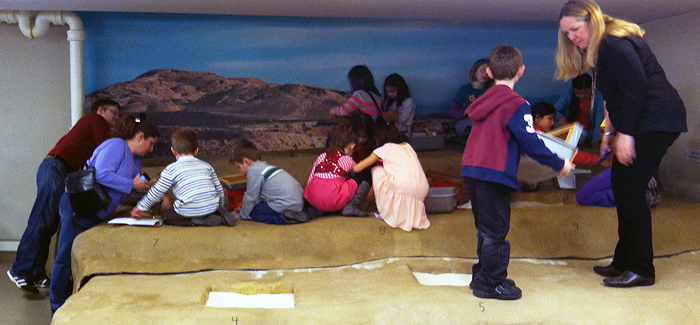
Junior archaeologists work on a “dig” at the Oriental Institute’s simulated Tel Megiddo. (Photography by Jeanie Chung)
Learning and shopping at the Oriental Institute.
The highlights of my daughter’s trip to the Oriental Institute last year when she was six were, in order:
1. Dinner and ice cream at the Med
2. The Suq, OI’s gift shop
3. Any interactive computer display
Since the OI is one of my favorite places on campus, I was disappointed that only one of the above activities took place in the museum proper. In search of a more hands-on experience, I took her and four of her friends to the OI’s Junior Archaeologists program earlier this month.
More than 30 children gathered in the Kipper Family Archaeology Discovery Center in the OI’s basement: some as young as 4 or 5, a few as old as 10 or 11, and almost all giddy from daylight savings time–induced sleep deprivation and the relatively balmy 40-degree weather.
But while they never would have made it through a lecture, playing in a sandbox was another story. After a brief discussion of what archaeologists study and how they study it, the group divided in half, with my daughter’s group working on a “dig” at a simulated Tel Megiddo—in this case a concrete pyramid with sand-filled trenches. Sifting through sand in their trench, my daughter and her friends carefully examined, measured, and drew the artifacts they found, including a bowl, a metal rosette, and what they decided was “Egyptian writing.” In their field notes, they answered questions like “What might this artifact be?” and “What might it tell us about ancient people?”
When the groups switched places, ours took a tour of the museum’s highlights. Midway through, the guide sat the kids down in front of the massive lammasu.
[[{"type":"media","view_mode":"media_original","fid":"1293","attributes":{"alt":"","class":"media-image","height":"440","typeof":"foaf:Image","width":"460"}}]]
A lammasu. (Photography by Corey Seeman, CC BY-NC-SA 2.0)
“What animals do you see?” our guide asked.
“A bull!”
“A bird!”
“A poodle?” Looking at the curly hair on the beast’s head, the kid had a point.
After dividing into small groups to act out portions of the inscription carved on the lammasu, the guide took the kids behind the enormous statue to see the back—something I’ve never done in my various adult tours.
Through the whole two hours, my daughter never once came over to ask to play with my phone or tell me she was hungry/bored/tired, which means I can fairly surmise she and her friends enjoyed themselves. I tried to ask them afterward, but they ran past me to the Suq.
